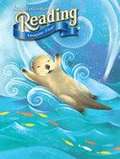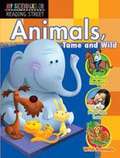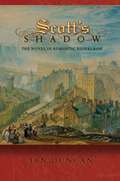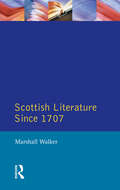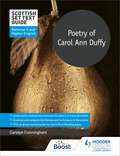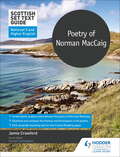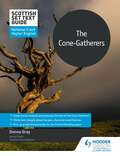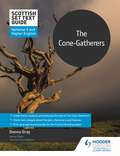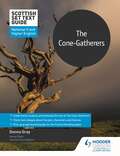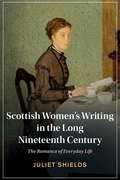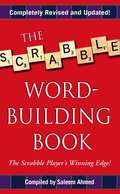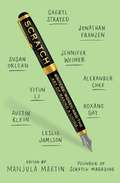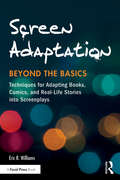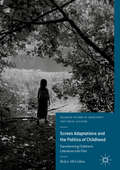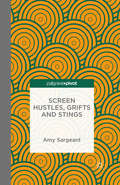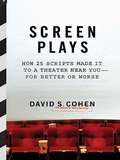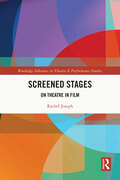- Table View
- List View
Scott Foresman Reading: Imagine That! (Reading Level 3.1)
by Candy Dawson Boyd Camille Blachowicz Wendy Cheyney Connie Juel Donald Leu Jeanne Paratore Sam Sebesta Karen Kring Wixson Peter Afflerbach James Beers Dolores Gaunty-Porter Deborad DiffilyQuality literature, built-in skill instruction, and test preparation help every child become a successful reader who is prepared for state and national tests. The Grade 1 On-Level Readers provide six weeks of review for the skills previously covered in kindergarten.
Scott Foresman Sidewalks, Animals Tame and Wild [Grade 1, Level A1]
by Sharon Vaughn Connie Juel Deborah Simmons Jeanne R. ParatoreNIMAC-sourced textbook
Scott's Shadow: The Novel in Romantic Edinburgh (Literature in History)
by Ian DuncanScott's Shadow is the first comprehensive account of the flowering of Scottish fiction between 1802 and 1832, when post-Enlightenment Edinburgh rivaled London as a center for literary and cultural innovation. Ian Duncan shows how Walter Scott became the central figure in these developments, and how he helped redefine the novel as the principal modern genre for the representation of national historical life. Duncan traces the rise of a cultural nationalist ideology and the ascendancy of Scott's Waverley novels in the years after Waterloo. He argues that the key to Scott's achievement and its unprecedented impact was the actualization of a realist aesthetic of fiction, one that offered a socializing model of the imagination as first theorized by Scottish philosopher and historian David Hume. This aesthetic, Duncan contends, provides a powerful novelistic alternative to the Kantian-Coleridgean account of the imagination that has been taken as normative for British Romanticism since the early twentieth century. Duncan goes on to examine in detail how other Scottish writers inspired by Scott's innovations--James Hogg and John Galt in particular--produced in their own novels and tales rival accounts of regional, national, and imperial history. Scott's Shadow illuminates a major but neglected episode of British Romanticism as well as a pivotal moment in the history and development of the novel.
Scottish Literature Since 1707 (Longman Literature In English Series)
by Marshall WalkerMarshall Walker's lively and readable account of the highs and lows of Scottish literature from this important date to the present addresses the important themes of democracy, power and nationhood. Disposing of stereotypical ideas about Scotland and the Scots, this fresh approach to Scottish literature provides a critical interpretation of its distinctive style and presents the reader with an informative introduction to Scottish culture. Coverage includes the Scottish enlightenment and the world of Boswell and David Hulme to the 'Scottish Renaissance', associated with Hugh MacDiarmaid. Developments in the contemporary literary scene include John McGrath's theatre Company and the fiction and poetry of Alaistar Gray and Ian Crichton Smith. Particular attention is given to the work of Scottish women writers such as Lady Grizel Baillie and Liz Lochhead, who have been much neglected in previous literature.
Scottish Rhetoric and Its Influences
by Lynee Lewis GailletAn outgrowth of the recent meeting of the International Society of the History of Rhetoric, this collection challenges the reader to reexamine the broad influence of 18th- and 19th-century Scottish rhetoric, often credited for shaping present-day studies in psychology, philosophy, literary criticism, oral communication, English literature, and composition. The contributors examine its influence and call for a new appraisal of its importance in light of recent scholarship and archival research. Many of the essays in the first section discuss the contributions of recognized influential figures including Adam Smith and Hugh Blair. Other essays focus on the importance of 18th-century Scottish sermons in relation to public discourse, audience analysis, peer evaluation, and professional rhetoric. Essays in the second section address 19th-century rhetorical theory and its influence on North American composition practice.
Scottish Set Text Guide: Poetry of Carol Ann Duffy for National 5 and Higher English (Scottish Set Text Guides)
by Carolyn CunninghamExam Board: SQALevel: National 5 and HigherSubject: EnglishFirst teaching: September 2017 (N5) / September 2018 (Higher)First exams: Summer 2018 (N5) / Summer 2019 (Higher)Understand, analyse, evaluate, succeed. This study and revision guide takes you through every aspect of Carol Ann Duffy's poetry, with exam advice for the National 5 and Higher English Critical Reading papers.Fully up to date with SQA's latest exam requirements, this book is written by an expert who knows what exam success looks like.> Develop understanding of language, structure and themes. Clear explanations and detailed commentary are supported by definitions of key terms and unfamiliar words> Build critical and analytical skills. Students are encouraged to think more deeply about the poems and consider the writers' ideas, choices and techniques> Receive advice on the Scottish Texts section of the exam. Sample questions with model answers and examiner-style commentary are supported by additional practice questions for students to do> Prepare for the Critical Essay section of the exam. With tips and examples for planning, structuring and writing a top-grade essay, plus practice essay questions for students to answer> Remember key quotations. A selection of quotes are highlighted throughout, so students can use them in the exam to make comparisons between different parts of the text> Review your learning. Quick questions at the end of each chapter check students' understanding of the poems
Scottish Set Text Guide: Poetry of Carol Ann Duffy for National 5 and Higher English (Scottish Set Text Guides)
by Carolyn CunninghamExam Board: SQALevel: National 5 and HigherSubject: EnglishFirst teaching: September 2017 (N5) / September 2018 (Higher)First exams: Summer 2018 (N5) / Summer 2019 (Higher)Understand, analyse, evaluate, succeed. This study and revision guide takes you through every aspect of Carol Ann Duffy's poetry, with exam advice for the National 5 and Higher English Critical Reading papers.Fully up to date with SQA's latest exam requirements, this book is written by an expert who knows what exam success looks like.> Develop understanding of language, structure and themes. Clear explanations and detailed commentary are supported by definitions of key terms and unfamiliar words> Build critical and analytical skills. Students are encouraged to think more deeply about the poems and consider the writers' ideas, choices and techniques> Receive advice on the Scottish Texts section of the exam. Sample questions with model answers and examiner-style commentary are supported by additional practice questions for students to do> Prepare for the Critical Essay section of the exam. With tips and examples for planning, structuring and writing a top-grade essay, plus practice essay questions for students to answer> Remember key quotations. A selection of quotes are highlighted throughout, so students can use them in the exam to make comparisons between different parts of the text> Review your learning. Quick questions at the end of each chapter check students' understanding of the poems
Scottish Set Text Guide: Poetry of Norman MacCaig for National 5 and Higher English (Scottish Set Text Guides)
by Jamie CrawfordExam Board: SQALevel: National 5 and HigherSubject: EnglishFirst teaching: September 2017 (N5) / September 2018 (Higher)First exams: Summer 2018 (N5) / Summer 2019 (Higher)Understand, analyse, evaluate, succeed. This study and revision guide takes you through every aspect of The Cone-Gatherers, with exam advice for the National 5 and Higher English Critical Reading papers.Fully up to date with SQA's latest exam requirements, this book is written by an expert who knows what exam success looks like.> Develop understanding of plot, structure, characterisation, themes and language. Clear explanations and detailed commentary are supported by definitions of key terms and unfamiliar words> Build critical and analytical skills. Students are encouraged to think more deeply about the text and consider the writers' ideas, choices and techniques> Receive advice on the Scottish Texts section of the exam. Sample questions with model answers and examiner-style commentary are supported by additional practice questions for students to do> Prepare for the Critical Essay section of the exam. With tips and examples for planning, structuring and writing a top-grade essay, plus practice essay questions for students to answer> Remember key quotations. A selection of quotes are highlighted throughout, so students can use them in the exam to make comparisons between different parts of the text> Review your learning. Quick questions at the end of each chapter check students' understanding of the text
Scottish Set Text Guide: Poetry of Norman MacCaig for National 5 and Higher English (Scottish Set Text Guides)
by Jamie CrawfordExam Board: SQALevel: National 5 and HigherSubject: EnglishFirst teaching: September 2017 (N5) / September 2018 (Higher)First exams: Summer 2018 (N5) / Summer 2019 (Higher)Understand, analyse, evaluate, succeed. This study and revision guide takes you through every aspect of The Cone-Gatherers, with exam advice for the National 5 and Higher English Critical Reading papers.Fully up to date with SQA's latest exam requirements, this book is written by an expert who knows what exam success looks like.> Develop understanding of plot, structure, characterisation, themes and language. Clear explanations and detailed commentary are supported by definitions of key terms and unfamiliar words> Build critical and analytical skills. Students are encouraged to think more deeply about the text and consider the writers' ideas, choices and techniques> Receive advice on the Scottish Texts section of the exam. Sample questions with model answers and examiner-style commentary are supported by additional practice questions for students to do> Prepare for the Critical Essay section of the exam. With tips and examples for planning, structuring and writing a top-grade essay, plus practice essay questions for students to answer> Remember key quotations. A selection of quotes are highlighted throughout, so students can use them in the exam to make comparisons between different parts of the text> Review your learning. Quick questions at the end of each chapter check students' understanding of the text
Scottish Set Text Guide: Sailmaker for National 5 English (Scottish Set Text Guides)
by David ThomasExam Board: SQALevel: National 5 and HigherSubject: EnglishFirst teaching: September 2017 (N5) / September 2018 (Higher)First exams: Summer 2018 (N5) / Summer 2019 (Higher)Understand, analyse, evaluate, succeed. This study and revision guide takes you through every aspect of The Cone-Gatherers, with exam advice for the National 5 and Higher English Critical Reading papers.Fully up to date with SQA's latest exam requirements, this book is written by an expert who knows what exam success looks like.> Develop understanding of plot, structure, characterisation, themes and language. Clear explanations and detailed commentary are supported by definitions of key terms and unfamiliar words> Build critical and analytical skills. Students are encouraged to think more deeply about the text and consider the writers' ideas, choices and techniques> Receive advice on the Scottish Texts section of the exam. Sample questions with model answers and examiner-style commentary are supported by additional practice questions for students to do> Prepare for the Critical Essay section of the exam. With tips and examples for planning, structuring and writing a top-grade essay, plus practice essay questions for students to answer> Remember key quotations. A selection of quotes are highlighted throughout, so students can use them in the exam to make comparisons between different parts of the text> Review your learning. Quick questions at the end of each chapter check students' understanding of the text
Scottish Set Text Guide: Sailmaker for National 5 English (Scottish Set Text Guides)
by David ThomasExam Board: SQALevel: National 5 and HigherSubject: EnglishFirst teaching: September 2017 (N5) / September 2018 (Higher)First exams: Summer 2018 (N5) / Summer 2019 (Higher)Understand, analyse, evaluate, succeed. This study and revision guide takes you through every aspect of The Cone-Gatherers, with exam advice for the National 5 and Higher English Critical Reading papers.Fully up to date with SQA's latest exam requirements, this book is written by an expert who knows what exam success looks like.> Develop understanding of plot, structure, characterisation, themes and language. Clear explanations and detailed commentary are supported by definitions of key terms and unfamiliar words> Build critical and analytical skills. Students are encouraged to think more deeply about the text and consider the writers' ideas, choices and techniques> Receive advice on the Scottish Texts section of the exam. Sample questions with model answers and examiner-style commentary are supported by additional practice questions for students to do> Prepare for the Critical Essay section of the exam. With tips and examples for planning, structuring and writing a top-grade essay, plus practice essay questions for students to answer> Remember key quotations. A selection of quotes are highlighted throughout, so students can use them in the exam to make comparisons between different parts of the text> Review your learning. Quick questions at the end of each chapter check students' understanding of the text
Scottish Set Text Guide: Tally's Blood for National 5 English (Scottish Set Text Guides)
by David ThomasExam Board: SQALevel: National 5 and HigherSubject: EnglishFirst teaching: September 2017 (N5) / September 2018 (Higher)First exams: Summer 2018 (N5) / Summer 2019 (Higher)Understand, analyse, evaluate, succeed. This study and revision guide takes you through every aspect of The Cone-Gatherers, with exam advice for the National 5 and Higher English Critical Reading papers.Fully up to date with SQA's latest exam requirements, this book is written by an expert who knows what exam success looks like.> Develop understanding of plot, structure, characterisation, themes and language. Clear explanations and detailed commentary are supported by definitions of key terms and unfamiliar words> Build critical and analytical skills. Students are encouraged to think more deeply about the text and consider the writers' ideas, choices and techniques> Receive advice on the Scottish Texts section of the exam. Sample questions with model answers and examiner-style commentary are supported by additional practice questions for students to do> Prepare for the Critical Essay section of the exam. With tips and examples for planning, structuring and writing a top-grade essay, plus practice essay questions for students to answer> Remember key quotations. A selection of quotes are highlighted throughout, so students can use them in the exam to make comparisons between different parts of the text> Review your learning. Quick questions at the end of each chapter check students' understanding of the text
Scottish Set Text Guide: Tally's Blood for National 5 English (Scottish Set Text Guides)
by David ThomasExam Board: SQALevel: National 5 and HigherSubject: EnglishFirst teaching: September 2017 (N5) / September 2018 (Higher)First exams: Summer 2018 (N5) / Summer 2019 (Higher)Understand, analyse, evaluate, succeed. This study and revision guide takes you through every aspect of The Cone-Gatherers, with exam advice for the National 5 and Higher English Critical Reading papers.Fully up to date with SQA's latest exam requirements, this book is written by an expert who knows what exam success looks like.> Develop understanding of plot, structure, characterisation, themes and language. Clear explanations and detailed commentary are supported by definitions of key terms and unfamiliar words> Build critical and analytical skills. Students are encouraged to think more deeply about the text and consider the writers' ideas, choices and techniques> Receive advice on the Scottish Texts section of the exam. Sample questions with model answers and examiner-style commentary are supported by additional practice questions for students to do> Prepare for the Critical Essay section of the exam. With tips and examples for planning, structuring and writing a top-grade essay, plus practice essay questions for students to answer> Remember key quotations. A selection of quotes are highlighted throughout, so students can use them in the exam to make comparisons between different parts of the text> Review your learning. Quick questions at the end of each chapter check students' understanding of the text
Scottish Set Text Guide: The Cone-Gatherers for National 5 and Higher English (Scottish Set Text Guides)
by Donna GrayExam Board: SQALevel: National 5 and HigherSubject: EnglishFirst teaching: September 2017 (N5) / September 2018 (Higher)First exams: Summer 2018 (N5) / Summer 2019 (Higher)Understand, analyse, evaluate, succeed. This study and revision guide takes you through every aspect of The Cone-Gatherers, with exam advice for the National 5 and Higher English Critical Reading papers.Fully up to date with SQA's latest exam requirements, this book is written by an expert who knows what exam success looks like.> Develop understanding of plot, structure, characterisation, themes and language. Clear explanations and detailed commentary are supported by definitions of key terms and unfamiliar words> Build critical and analytical skills. Students are encouraged to think more deeply about the text and consider the writers' ideas, choices and techniques> Receive advice on the Scottish Texts section of the exam. Sample questions with model answers and examiner-style commentary are supported by additional practice questions for students to do> Prepare for the Critical Essay section of the exam. With tips and examples for planning, structuring and writing a top-grade essay, plus practice essay questions for students to answer> Remember key quotations. A selection of quotes are highlighted throughout, so students can use them in the exam to make comparisons between different parts of the text> Review your learning. Quick questions at the end of each chapter check students' understanding of the text
Scottish Set Text Guide: The Cone-Gatherers for National 5 and Higher English (Scottish Set Text Guides)
by Donna GrayExam Board: SQALevel: National 5 and HigherSubject: EnglishFirst teaching: September 2017 (N5) / September 2018 (Higher)First exams: Summer 2018 (N5) / Summer 2019 (Higher)Understand, analyse, evaluate, succeed. This study and revision guide takes you through every aspect of The Cone-Gatherers, with exam advice for the National 5 and Higher English Critical Reading papers.Fully up to date with SQA's latest exam requirements, this book is written by an expert who knows what exam success looks like.> Develop understanding of plot, structure, characterisation, themes and language. Clear explanations and detailed commentary are supported by definitions of key terms and unfamiliar words> Build critical and analytical skills. Students are encouraged to think more deeply about the text and consider the writers' ideas, choices and techniques> Receive advice on the Scottish Texts section of the exam. Sample questions with model answers and examiner-style commentary are supported by additional practice questions for students to do> Prepare for the Critical Essay section of the exam. With tips and examples for planning, structuring and writing a top-grade essay, plus practice essay questions for students to answer> Remember key quotations. A selection of quotes are highlighted throughout, so students can use them in the exam to make comparisons between different parts of the text> Review your learning. Quick questions at the end of each chapter check students' understanding of the text
Scottish Women's Writing in the Long Nineteenth Century: The Romance of Everyday Life (Cambridge Studies in Nineteenth-Century Literature and Culture)
by Juliet ShieldsWalter Scott's tales of chivalry and adventure inaugurated a masculinized Scottish romance tradition that celebrated a sublime and heroic version of Scotland. Nineteenth-century Scotswomen responded to Scott's influence by establishing a counter-tradition of unromantic or even anti-romantic representations of Scotland. Their novels challenged the long-standing claim that Scotland lacked any equivalent to the English realist novel. In turning from the past to the present and from the sublimity of Scott's Highland landscapes to farmhouses, factories, and suburban villas, Scottish women writers brought romance to everyday life, illuminating the magnificence of the mundane. Drawing on the evangelical discourses emerging from the splintering of the Presbyterian Church in 1843, they represented fiction as a form of spiritual comfort, an antidote to the dreary monotony and petty frustrations of daily existence. This volume introduces the previously overlooked tradition of nineteenth-century Scottish women's writing, and corrects previously male-dominated histories of the Scottish novel.
Scrabble Word-Building Book
by Saleem AhmedWant to outsmart, outwit, and outplay your Scrabble® opponents? Using the completely revised and updated The Scrabble® Word-Building Book, you can! This essential strategy guide shows you how to build on your opponents' words and become a master of this classic game. For novice players and expert wordsmiths alike, this helpful reference includes: A handy list of the 94 two-letter words sure to pile on the points Over 800 three-letter words -- 550 of which can be formed from two-letter words All eight-letter words that can be formed from seven-letter words Every word up to seven letters you can play! To increase your word-building power and achieve the highest score, keep The Scrabble® Word-Building Book at your fingertips -- and beat your opponent every time!
Scratch: Writers, Money, and the Art of Making a Living
by Manjula MartinA collection of essays from today’s most acclaimed authors—from Cheryl Strayed to Roxane Gay to Jennifer Weiner, Alexander Chee, Nick Hornby, and Jonathan Franzen—on the realities of making a living in the writing world.In the literary world, the debate around writing and commerce often begs us to take sides: either writers should be paid for everything they do or writers should just pay their dues and count themselves lucky to be published. You should never quit your day job, but your ultimate goal should be to quit your day job. It’s an endless, confusing, and often controversial conversation that, despite our bare-it-all culture, still remains taboo. In Scratch, Manjula Martin has gathered interviews and essays from established and rising authors to confront the age-old question: how do creative people make money? As contributors including Jonathan Franzen, Cheryl Strayed, Roxane Gay, Nick Hornby, Susan Orlean, Alexander Chee, Daniel Jose Older, Jennifer Weiner, and Yiyun Li candidly and emotionally discuss money, MFA programs, teaching fellowships, finally getting published, and what success really means to them, Scratch honestly addresses the tensions between writing and money, work and life, literature and commerce. The result is an entertaining and inspiring book that helps readers and writers understand what it’s really like to make art in a world that runs on money—and why it matters. Essential reading for aspiring and experienced writers, and for anyone interested in the future of literature, Scratch is the perfect bookshelf companion to On Writing, Never Can Say Goodbye, and MFA vs. NYC.
Screen Adaptation: Techniques for Adapting Books, Comics and Real-Life Stories into Screenplays
by Eric R. WilliamsOnce you understand the basics of screenwriting, ideas for your next screenplay are everywhere. Whether it comes from a favorite children’s book, a summer novel you discover accidentally, a news story that catches your imagination, or a chapter from your own life — advanced screenwriting strategies should now guide you through your first adaptation. In Screen Adaptation: Beyond the Basics, award-winning screenwriter Eric Williams uses examples from award-winning screenplays to explain new storytelling techniques. His real-world examples illustrate a range of advanced approaches — including new ways to identify and craft tension, how to reimagine structure and character, and how to strengthen emotional depth in your characters and in the audience. Screen Adaptation: Beyond the Basics teaches readers new ways to engage with source material in order to make successful adaptation decisions, regardless of the source material. The book offers: Three detailed examples of award-winning adaptations by the author, including the complete short story and final scripts used in the Voices From the Heartland project; Breakout boxes highlighting modern and historical adaptations and providing examples for each concept discussed in the book; More than fifty charts providing easy-to-use visual representations of complex concepts; New screenwriting techniques developed by the author, including the Triangle of Knowledge, the Storyteller’s Parallax, and the idea of Super Genres as part of a Screenwriters Taxonomy.
Screen Adaptations and the Politics of Childhood
by Robyn McCallumIn seeing adaptation as a dialogic process that results in an intricate web of intertextuality, this book features a cutting edge approach to the study of film adaptations of literature for children and young people, and the narratives about childhood those adaptations enact. Historically, film media has always had a partiality for adaptation of literary sources, especially 'classic' literary texts for children. As economic and cultural commodities, such screen adaptations play a crucial role in the cultural reproduction and transformation of childhood and youth and are a rich resource for the examination of changing cultural values and ideologies, especially contested narratives of childhood. Focusing on a range of literary and film genres, from 'classic' texts, to experimental, carnivalesque, magical realist, and cross-cultural texts it examines various representations of childhood: as shifting states of innocence and wildness, liminality, marginalisation and invisibility.
Screen Hustles, Grifts and Stings: Stings, Grifts, Hustles and the Long Con
by A. SargeantScreen Hustles, Grifts and Stings identifies recurrent themes and techniques of the con film, suggests precedents in literature and discusses the perennial appeal of the con man for readers and viewers alike. Core studies span from film (Catch Me If You Can, Paper Moon, House of Games) to television (Hustle), from Noir (The Grifters) to Romantic Comedy (Gambit). Frequently, the execution of the con is only finely distinguishable from the conduct of a legitimate profession and, challengingly, a mark is often shown to be culpable in his or her undoing. The best con films, it is suggested, invite re-watching and reward the viewer accordingly: who is complicit and when? How and where is the con achieved? When is the viewer party to the con? And what, if any, moral is to be drawn?
Screen Plays: How 25 Scripts Made It to a Theater Near You--for Better or Worse
by David S. CohenIn this fascinating survey of contemporary screen craft, David Cohen of Script and Variety magazines leads readers down the long and harrowing road every screenplay takes from idea to script to screen. In interviews with Hollywood screenwriters from across the board-Oscar winners and novices alike-Cohen explores what sets apart the blockbuster successes from the downright disasters. Tracing the fortunes of twenty-five films, including Troy, Erin Brockovich, Lost in Translation, and The Aviator, Cohen offers insider access to back lots and boardrooms, to studio heads, directors, and to the over-caffeinated screenwriters themselves. As the story of each film evolves from the drawing board to the big screen, Cohen proves that how a script is written, sold, developed, and filmed can be just as dramatic and intriguing as the movie itself-especially when the resulting movie is a fiasco. Covering films of all kinds-from tongue-in-cheek romps like John Waters's A Dirty Shame to Oscar winners like Monster's Ball and The Hours-Screen Plays is an anecdote-filled, often inspiring, always revealing look at the alchemy of the movie business. With Cohen as your expert guide, Screen Plays exposes how and why certain films (such as Gladiator) become "tent poles," those runaway successes every studio needs to survive, and others become train wrecks. Full of critical clues on how to sell a script-and avoid seeing it destroyed before the director calls Action!-it's the one book every aspiring screenwriter will find irresistible.
Screened Stages: On Theatre in Film (ISSN)
by Rachel JosephThis book is devoted to tracing the variety of ways that theatre, theatricality, and performance are embedded in Hollywood cinema as screened stages.A screened stage is the literal or metaphorical appearance of a stage on screen. When the Hollywood style emerged in cinema history it traumatically severed the entwined relationship between film and theatre. The book makes the argument that cinema longs for theatre after that separation. The histories of stage and screen persistently crisscross one another making their separation problematic. The screened stage from the end of the nineteenth century until now offers a miniaturized version of cinema and theatre history. Moments of the stage within the screen compress historical styles and movements into saturated representations on film. Such examples overflow the cinematic screen into singular manifestations of presentness. Screened stages uncover what it means to be simultaneously present and absent.This book would be of great interest to students and scholars of theatre, film, dance, and performance.
